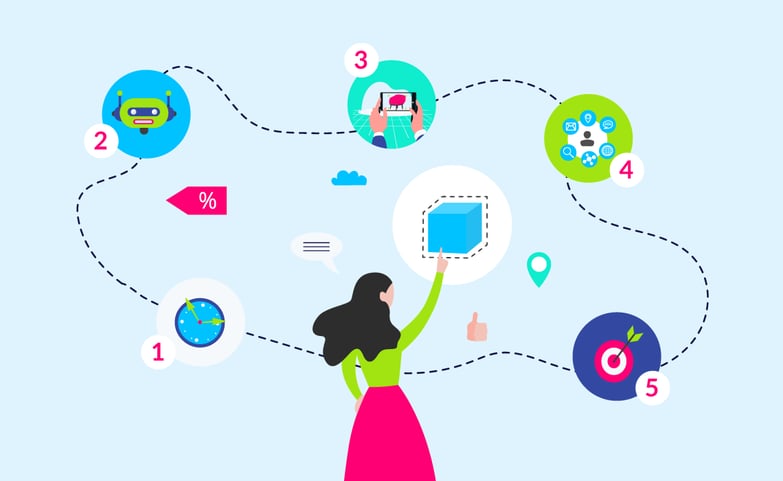In the age of marketing automation, programmatic printing is rapidly winning ground as a concept that combines the emotional impact of individualized print with the immediacy of digital marketing — offering promising commercial results for organizations. If you have a business, chances are you’re using digital marketing channels to advertise to your target audience. Between email, social and search advertising, it can seem like there’s little room for another channel to succeed — but that might be wrong.
Digital programmatic advertising created amazing opportunities for brands and paved the way for advanced personalization and retargeting strategies. Yet now, as the noise from digital channels gets louder, it’s losing some of its power. In fact, almost one-third of consumers report feeling overwhelmed by the number of devices and subscriptions they need to manage, according to Deloitte’s “2022 Connectivity and Mobile Trends Survey.”
So, what’s the solution? You can’t disregard digital programmatic altogether, but you can combine it with a channel that consumers engage with away from the screen and on their own time — print. So, what exactly is programmatic printing and why does it matter to your marketing strategy? Let’s dive in.
What is programmatic printing?
Programmatic printing (or programmatic print) is the use of programmatic ad selling and distribution methods for traditional direct mail and print ads. The foundation for programmatic printing was laid by the latest generation of digital printing machines. These not only enable extremely fast and personalized printing but are also cost-efficient and produce high-quality results. With an integrated programmatic printing solution, digital data can be used to generate printed marketing communications within a short timeframe. It includes the full range of promotional print: catalogs, brochures, magalogs, customer magazines, customer newsletters, brand books, etc.
This gives customers the best of both worlds — data-driven propositions with the emotional appeal of high-quality print. By implementing programmatic printing, marketers and print service providers (PSPs) can collaborate on omnichannel campaigns that combine all the advantages of print with those of digitalization — such as the ability to instantly address consumers with personalized content.
How does programmatic printing work in practice?
Unlike conventional campaign planning, with programmatic printing, customers do not receive any mass mailings planned by the company. Instead, the customer elicits a trigger, which in turn initiates the sending of a mailing. For instance, a predefined trigger could be abandoning a shopping cart which then activates the workflow for programmatic printing. The marketing automation software then transfers the data to the personalization software that creates a customized layout for the customer.
Next, the digital printing partner receives the layout, including encrypted address data, and uses it to create and send the print asset. The customer receives the individual print ad a short time after abandoning their shopping cart. But to make all this possible, organizations should have a strong grip on their data. As Sebastian Hardung, Chief Marketing Officer at Priint Group explains, "For programmatic printing, as for any other marketing campaign, data is the be-all and end-all."
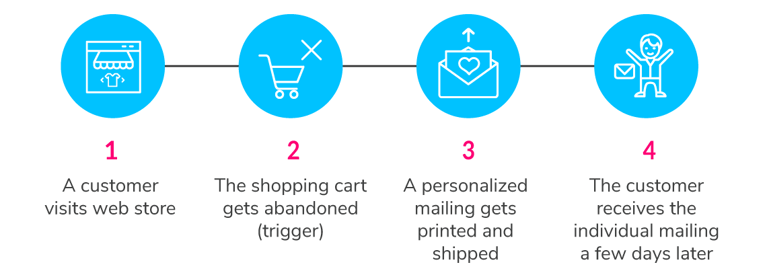 How does programmatic printing work in practice?
How does programmatic printing work in practice?
What are the benefits of programmatic printing?
It's easy to assume that print marketing has become less relevant in the digital age. While it’s true that the print medium is long past its heyday in terms of demand, the appeal of print ads is still strong. Print offers a complete, distraction-free and immersive customer experience. When you take that and combine it with programmatic to make it highly relevant and personalized, it can make the difference between a good campaign and a great one. Here are five ways programmatic printing can help you ramp up your marketing efforts:
1. Automation
The commercial printing industry has embraced automation with 31.4% of its print volume produced using automated workflows. This is also a trend in programmatic printing that would not be possible without sophisticated automated production workflows. The term programmatic refers to the data that is compiled automatically for a digital print. It draws from the same data you’d use to send a personalized email or trigger a banner ad. But instead, the end product is an emotionally appealing, high-quality print asset that reaches the consumer usually within 24 hours of their interaction with your brand.
For instance, someone has searched for a winter jacket but has not bought it. And the next day he receives a flyer with a special offer or even a personal discount code for a winter jacket. Thanks to automation technology, a classic advertising mail becomes a highly individualized mailing.
2. Trustworthiness
Making a purchase is usually a matter of trust. When it comes to influencing consumers' purchasing choices, print advertising is still considered by 82% of consumers the most trustworthy medium. Clearly, print ads, while they cannot reverse the decline of the medium, have undeniable appeal and still have a place in today's marketing landscape. The internet has made research easier, but with so much information online, it can be hard to tell facts from fiction.
Consumers are more aware of disinformation and widely used tactics of dishonest advertising, particularly online. In contrast, they believe that print media production requires much more rigor, hence garnering higher trust rates among customers even today.
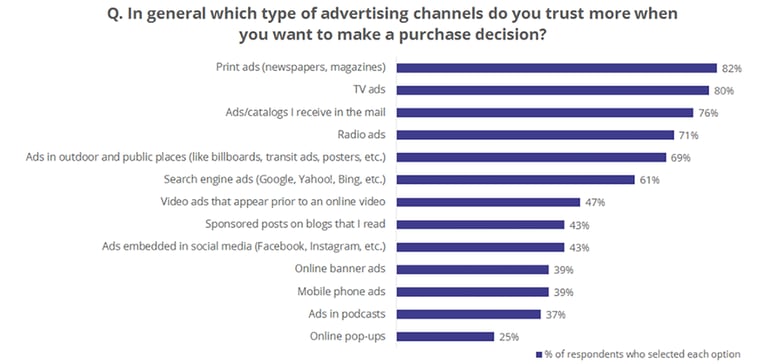 Print is the advertising channel that consumers trust most when making a purchase decision.
Print is the advertising channel that consumers trust most when making a purchase decision.
3. Cost efficiency and convenience
Planning print campaigns can be a complex undertaking: you need to hire a print service provider, supply them with relevant customer data and manage the entire process. But with programmatic printing automation, you can streamline campaign planning by eliminating multiple rounds of corrections from your workflow — saving you time and money. In general, basic layouts and shipping days only need to be defined once while texts and images are comprised of predefined personas, logic and designated triggers. Creation is triggered automatically, making lengthy approval processes and the associated costs obsolet.
4. Untapped target groups
For advertisers, programmatic printing unlocks opportunities to reach previously untapped, non-digital or digitally fatigued audiences. Consumers are mostly wary about display ads or don’t see them at all. Print marketing, on the other hand, has the potential to stand out. For instance, while Millennials receive hundreds of emails every week, mail comes less frequently. As a result, this age group doesn’t feel the need to tune out the messaging. In one survey, 62% of Millennials said they had visited a store in the past month based on information received in the mail — more often than Baby Boomers and Gen Xers had.
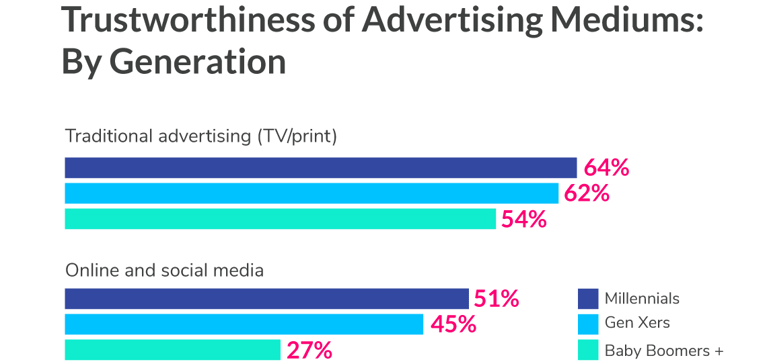 Millennials, Gen Xers and Baby Boomers trust traditional ads (print/TV) more compared to online and social media ads.
Millennials, Gen Xers and Baby Boomers trust traditional ads (print/TV) more compared to online and social media ads.
5. Revenue maximization
By using programmatic printing, you can minimize costs while boosting conversion rates. It makes it possible to send tailored print mailings to relevant customers, based on their behavior and characteristics, saving you money that would be wasted on irrelevant mailings. At the same time, high mailing relevance means improved conversion rates, as you contact customers at the right time with the right product or appeal. Indeed, nearly 80% of consumers act on direct printed mail advertisements compared to 45% of consumers that act on electronic advertisements. On top of that, you can collect data insights that reveal valuable cross- and upselling opportunities.
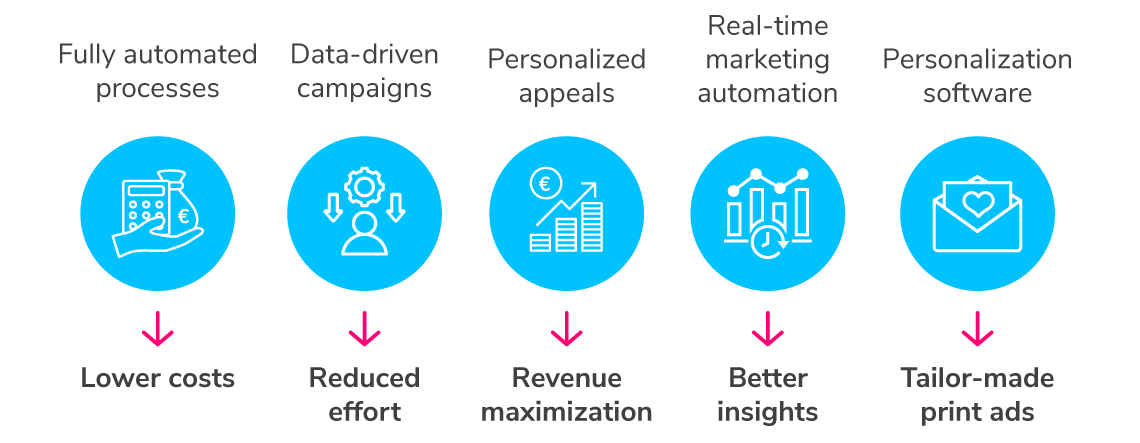 Elements of programmatic printing
Elements of programmatic printing
Make an impact with programmatic printing
Advances in digital printing technology and automated production workflows over the last few years have ushered in a new era of opportunity for programmatic printing materials, allowing you to take the best aspects of digital advertising away from the screens everyone is so tired of. With the average consumer’s attention span being only eight seconds, it’s crucial for brands to reach their target audiences directly.
While email marketing alone may be the most widely used and cost-effective tool to engage with customers, you should not overlook the importance of print ads. A campaign that combines print and digital ads provides a more impactful, multi-touch message that can be 400% more effective. Successful multichannel publishing will not only help prospective clients learn about your organization’s business, products and services, but it will also build brand authority and trust when it comes to consumers making purchasing decisions.




